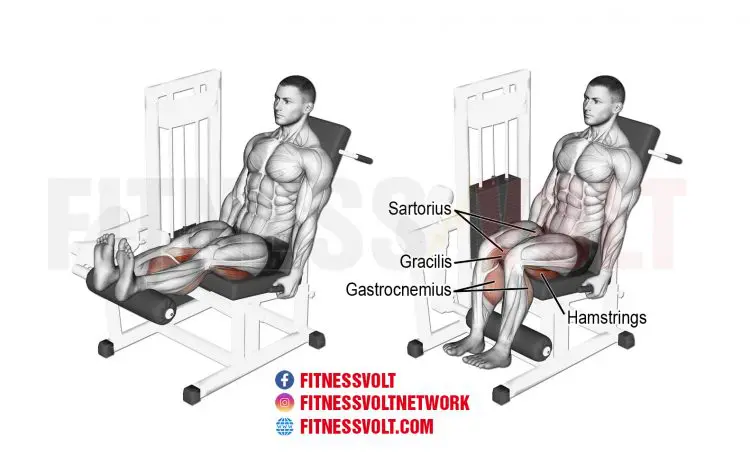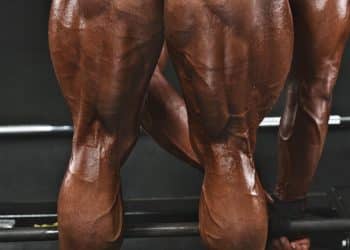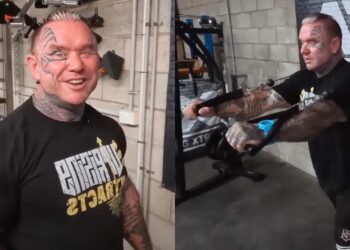The seated leg curl is an exercise which builds muscle and strength in the hamstrings of the posterior chain (Backside of the body). Now, this exercise is a variation of the leg curl since there are several ways to do the exercise but it’s always great to include variety in your training.
Machines are very beneficial because you only have to focus on the movement and stabilization is not required. But since the leg curl is an isolation exercise, this is ideal and you can really stimulate your hamstrings thoroughly. So combine the leg curl with your other hamstring exercises for maximum development.
In This Exercise:
- Target Muscle Group: Hamstrings
- Type: Strength
- Mechanics: Isolation
- Equipment: Leg curl machine
- Difficulty: Beginner
Understanding the Seated Leg Curl
The seated leg curl is a compound exercise that primarily engages the hamstring muscles, which are located at the back of your thigh. This exercise is performed using a specialized seated leg curl machine commonly found in gyms. By isolating the hamstrings, the seated leg curl provides an efficient and targeted workout, allowing you to develop strength, stability, and muscular balance in your lower body.
The Muscles Involved
When performing the seated leg curl exercise, you engage various muscles in your lower body. Understanding which muscles are involved will give you a clearer picture of how this exercise can benefit your leg training. Let’s take a closer look at the key muscles targeted during the seated leg curl:
- Hamstrings: The hamstrings are a group of muscles located at the back of your thigh. They consist of the biceps femoris, semitendinosus, and semimembranosus muscles. These muscles play a significant role in bending your knee and extending your hip. During the seated leg curl, the hamstrings are the main focus, and the exercise helps strengthen and develop these muscles.
- Gastrocnemius: The gastrocnemius, also known as the calf muscle, is situated at the back of your lower leg. Although it’s not the primary muscle targeted in the seated leg curl, it assists in maintaining balance and stability during the exercise.
- Popliteus: The popliteus muscle is a smaller muscle located at the back of your knee joint. Its main function is to unlock the knee joint during movements that involve knee flexion, such as those performed during the seated leg curl.
- Gluteus Maximus: The gluteus maximus, the largest muscle in your buttocks, indirectly comes into play during the seated leg curl. As your hamstrings contract to bend the knee, the gluteus maximus helps stabilize the hip joint and maintain proper alignment throughout the exercise.
- Adductor Magnus: Situated on the inner thigh, the adductor magnus assists in hip adduction, which involves bringing the leg inward toward the midline of your body. Although it isn’t a primary mover during the seated leg curl, it contributes to overall lower body stability during the exercise.
Perfecting the Technique
To perform the seated leg curl correctly, follow these steps:
Level Up Your Fitness: Join our 💪 strong community in Fitness Volt Newsletter. Get daily inspiration, expert-backed workouts, nutrition tips, the latest in strength sports, and the support you need to reach your goals. Subscribe for free!
- Positioning: Sit on the machine with your back flat against the pad. Position your legs under the padded lever with the pad resting just above your ankles.
- Grip: Hold the side handles for stability. This ensures that you use only your leg muscles, maintaining the isolation necessary for effective training.
- Execution: Exhale and curl your legs towards your body as far as possible without lifting your thighs off the pad. Hold the contraction for a moment.
- Return: Inhale and slowly return to the starting position. This controlled movement ensures that your muscles are engaged throughout the exercise.
Exercise Instructions
- Sit on the machine seat and adjust the padded lever to secure your body in place.
- Then, adjust the leg curl lever so your ankles are resting on top of the pads.
- Grip the handles and curl the weight toward your body by bending your knees and flexing your hamstrings. Exhale during this portion of the exercise.
- Now, slowly lift your legs back up by straightening out your legs but don’t lock out your knees. Inhale during this portion of the exercise.
- Repeat for the desired number of reps.
Variations & Tips:
- You can perform the lying leg curl as an alternative.
- Always use a full range of motion during the seated leg curl.
- Do not lock out your knees during the exercise.
- The seated leg curl works the hamstrings muscles of the posterior chain.
Watch: How to do the seated leg curl
Common Mistakes and How to Avoid Them
When performing seated leg curls, be sure to avoid these common errors:
- Rushing the Movement: Maintain control throughout the exercise. Fast, jerky movements can result in injuries and reduce the effectiveness of the workout.
- Lifting the Hips: Keep your hips and thighs firmly against the seat throughout the motion. Lifting them can strain your lower back.
- Incorrect Pad Position: The pad should rest just above your ankles, not on the calves. The incorrect placement can lead to inadequate hamstring engagement.
Variations and Progressions
Once you have mastered the basic seated leg curl, you can explore variations and progressions to continually challenge your muscles and keep your leg training routine dynamic. Here are a few options to consider:
1. Single-Leg Seated Leg Curl
By performing the seated leg curl exercise with one leg at a time, you increase the demand on each hamstring individually, leading to greater muscular activation and balance.
2. Drop Sets
Implementing drop sets involves performing multiple sets of the seated leg curl exercise with decreasing weights, pushing your muscles to fatigue and stimulating further growth and strength development.
3. Superset with Leg Extensions
To maximize your leg workout, pair the seated leg curl with leg extensions. This superset targets both the hamstrings and quadriceps, providing a comprehensive lower body workout.
Conclusion
In conclusion, the seated leg curl is a highly effective exercise for targeting and developing your hamstring muscles. By incorporating this exercise into your leg training routine, you can enhance muscle strength, stability, and overall leg development. Remember to execute the seated leg curl with proper form and technique, avoid common mistakes, and explore variations and progressions to continually challenge your muscles. Take your leg training to new heights with the seated leg curl and reap the rewards of a well-rounded lower body workout.
Interested in measuring your progress? Check out our strength standards for Hip Adduction, Lying Leg Curl, Seated Leg Curl, and more.









